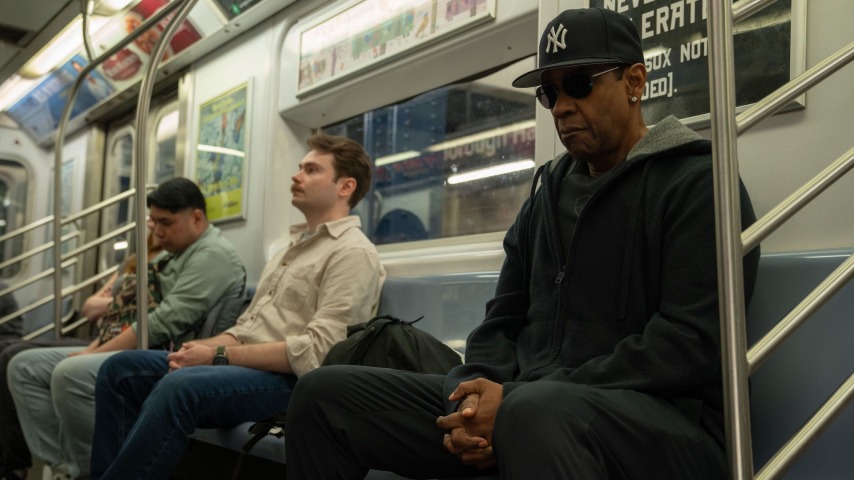There is no reason for the first hour of Highest 2 Lowest to look as bad as it does. Spike Lee‘s first narrative feature since Da 5 Bloods in 2020 adapts Akira Kurosawa’s High And Low, an airtight crime thriller that begins with a crisis and swiftly follows it up with a moral quandary. A wealthy businessman learns his son has been kidnapped, but in reality the kidnappers took his chauffeur’s son. This seriously tests the man’s ethics, because paying the ransom would put him in financial jeopardy—and it’s not even his flesh and blood on the line. In the lead role, Kurosawa cast his then-muse Toshiro Mifune; by way of acknowledging the precedent set by the Japanese master, Lee casts his best leading man, Denzel Washington, as music mogul David King, whose attempts to keep hold of his iconic but stagnated label Stackin’ Hits Records are upset by a kidnapping and the $17.5 million in Swiss Franc notes that the shit-talking assailant (A$AP Rocky) demands from him. But it’s not until David leaves his swanky apartment, adorned with portraits of historic Black musicians and contemporary art, with a bag full of cash, that Highest 2 Lowest gets a jolt of formal adrenaline and finally matches the committed, livewire energy of its lead performer.
Over the first act of High And Low (itself based on Ed McBain’s novel King’s Ransom), detectives descend upon a shoe magnate’s hilltop home, and through Kurosawa’s impeccable stagecraft, every power dynamic, flash of vulnerability, and rapid strategizing is captured in the blocking of the actors and the position of the camera. High And Low understands how the body can communicate drama in tandem with other bodies, and before the ransom money is dropped from a speeding train window an hour into the film, the drama has been amplified enough to propel the audience to its somber, atmospheric resolution. But even though Lee’s modern reimagining boasts an impressive and kinetic second hour that puts a playful, unexpected pressure on the characters, the entire hostage deliberation sequence is shot, edited, and color timed without a shred of vitality and urgency—and worsened by an anonymous but forcefully ever-present piano and strings score by Howard Drossin that tries to smother the performances and drama with a layer of blandness.
It is not incumbent on Spike Lee to compete with Kurosawa; time and time again, the filmmaker has proven a unique formal prowess and a directorial eye that underlines the energy and tension of his scenes. So why doesn’t any of that come across for big stretches of Highest 2 Lowest? His camera only has an eye for his performers: Washington lights up the screen as a smooth-talking husband, playfully lecturing father, and fatcat businessman, clad in sharp suits and a coat of armor that repels the doubts of colleagues about the state of the business.
At the same time, he’s also hugely hubristic, deeply concerned about his legacy as a curator of Black art and as a New York bigwig. He projects the vibe of a smart, candid patron to Paul (Jeffrey Wright), his chauffeur and longtime friend, but the kidnapping throws their bond into jeopardy when David must decide how to save Paul’s son. Here, Washington’s egotistical indecision (including a scene where his son criticizes how he’s handled the kidnapping and David tries to intimidate him in return) is complemented by the jumpy desperation of Wright, even if the class tensions of ’50s Japan have not been translated into equally rigid observations of the class hierarchy of contemporary Black New Yorkers.
But Highest 2 Lowest delivers on its terrifically entertaining setup (or, “goes Spike Lee mode”) when David agrees to the ransom drop, for a number of reasons: Lee relishes his New York homecoming by crosscutting between a Puerto Rican festival and a subway car of Yankee fans as the money drop speedily approaches. It’s not just pulse-quickening tension in Lee’s rapid style, but from here the film properly emerges. This thriller positions two men of ambition against each other, exposing the old guard’s vulnerabilities so that, through a suspense plot, they can work through their insecurities and triumphantly refuse to capitulate to insolent young upstarts.
As the second half of William Alan Fox’s script slips away from the structure of High And Low, the diminished presence of the smooth, unmotivated Apple TV+ shooting style makes everything more compelling: Washington and Wright reject the passivity of their roles in the investigation, turning into motivated and comic vigilantes pursuing their suspect “Yung Felony.” It leads to a tête-à-tête showdown on either side of the glass of a recording booth where Washington, Rocky, and Lee lance the sparky generational conflict stewing among the thriller mechanics; it’s some of Washington and Lee’s best material together. The problem with Highest 2 Lowest is not that it doesn’t contain the expected magic of Spike Lee and Denzel Washington making a big-leagues New York remix of one of the best thrillers in cinema, but that the magic sits so clumsily alongside spells of uncanny mediocrity.
Director: Spike Lee
Writer: William Alan Fox
Starring: Denzel Washington, Ilfenesh Hadera, Jeffrey Wright, ASAP Rocky, Ice Spice
Release Date: August 22, 2025


 Keep scrolling for more great stories from The A.V. Club.
Keep scrolling for more great stories from The A.V. Club.